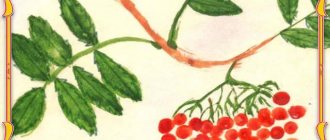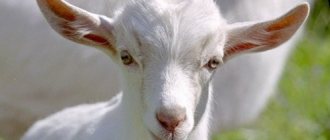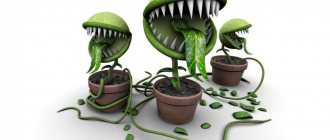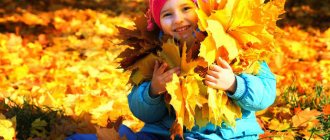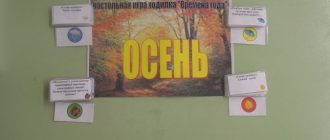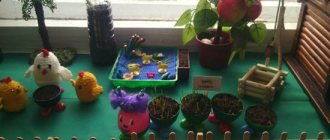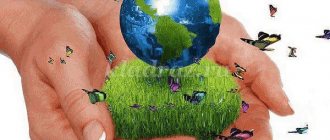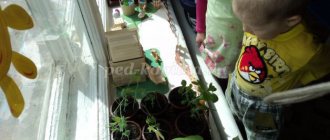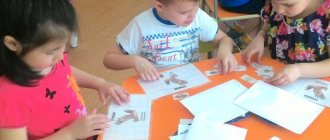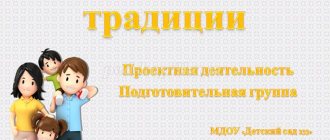MAGAZINE Preschooler.RF
Project “Autumn is a wonderful time”Purpose, direction of the project:
Research activities to study nature in all its manifestations in the autumn period, as well as creative expression of one’s impressions in the creation of decorative compositions.
Tasks:
- Expand your understanding of the variety and benefits of vegetables and fruits ripened in the autumn;
- To form: the foundations of the ecological culture of preschoolers through practical activities, observations, experiments, research work and work with didactic material; skills in artistic performance of various images during singing, dramatizations and games; children's spatial competence;
- Improve: knowledge about changing weather conditions; the ability to observe living objects and inanimate natural phenomena in the autumn;
- Focus children's attention on surrounding natural objects;
- Promote the development of memory, perception, logical thinking;
- To cultivate aesthetic feelings, interest in cognitive activities, and the ability to work in a team.
Type of project: informational and creative, collective
Children's age: 4-7 years
Project duration: 3 months (September – November)
Social partners: children, parents, teachers, music director.
Project implementation forms:
- classes;
- entertainment for children;
- exhibition of crafts made from natural materials;
- didactic, role-playing, Russian folk games;
- conversations;
- viewing illustrations, postcards;
- excursions to the autumn park and vegetable store;
- use of multimedia presentations;
- working with parents.
Expected result:
- Children’s knowledge about autumn, its signs and gifts will expand;
- Your vocabulary will be expanded;
- Activity and interest in the educational process will be formed in children and their parents;
- An interest in learning about the environment will be established.
Stages of work on the project:
1. Preparatory stage: (20.08 – 30.08.2015)
Drawing up a plan for joint work with children, teachers and parents:
Educators:
Selection of materials and equipment for classes, conversations, and games with children.
Musical director:
selection of songs, musical games, dance compositions related to the theme of the project.
Cooperation with parents:
Design of the exhibition of crafts “Gifts of Autumn”
Design of folders for parents on the topic of the project, a selection of photographs, literature.
Conversations with parents about their necessary participation in the project, about a serious attitude towards the educational process in the preschool educational institution.
2.
3. Main stage: (01.09.2015 – 20.11.2015)
Activities for working with children: reading fiction, watching fiction and multimedia presentations, conversations, classes, entertainment, excursions, observations, drawing, appliqué, making crafts from natural materials, didactic and Russian folk games.
- Reading fiction: And Bunin “Fall of Leaves” , V. Dal “The War of Mushrooms and Berries” , A. Pushkin “The Sky Was Breathing in Autumn” , M. Voloshin “In Autumn” .
- View the film: “Cipollino” , “Tops and Roots” , “Thumbelina” , “Sack of Apples” .
- Examination of reproductions of paintings: I. Levitan “Golden Autumn”, M. Nesterov “Autumn Landscape”, E. Volkov “Swamps in Autumn”, K. Vasiliev “Autumn” , V. D. Polenov “Early Snow” , “Golden Autumn” , A.M. Vasnetsov “Autumn” , I.I. Shishkin “Golden Autumn” , I.I. Levitan "October" , "In the Forest in Autumn"
- View presentations: “Vegetables” , “Fruits” , “What is autumn?” , “Autumn Sketches” , “Autumn Transformations” , “Why is November piebald?” (Sladkov), “Seasons” , “12 months” , “Seasons” .
- Conversations and classes: “Vitamin basket” , “Composing a story based on a painting by I.I. Levitan “Golden Autumn” , “Drafting a descriptive story about vegetables based on a model” , “Vitamin family” (salad making), “Our cheerful garden, what doesn’t grow here”
- Observations were carried out daily on walks, according to long-term planning.
- Excursions: “Excursion to the autumn park” , “Excursion to the vegetable store” .
- Work on the site: harvesting vegetables, planting before winter (garlic, carrots).
- Drawing: “The beauty of autumn leaves” (middle group), drawing a still life of vegetables, drawing fruits and vegetables (senior and preparatory groups).
- Application: “Transformation of an autumn leaf” (floristry), “Vitamin basket” (complex activity), “Funny carrots” (torn).
- Construction and manual labor: “Vegetable storage” (large and small building material), “Harvest” (waste and natural material), “Apple tree” (wire, beads), “Tale in the autumn forest” (natural material), “Hedgehog with supplies " (natural material), "Vegetables and fruits for the store" (salted dough).
- Didactic games: “The fourth odd one” , “Listen, remember, repeat” , “Name it affectionately” , “What’s missing?” , “Say the other way around” , “A lot is not enough” , “Gegetable shop” .
- Russian folk games: “Gardener” , “By the bear in the forest” ,
- Musical games: “On the Street” , “Rain” , “Sunny”, “Gardeners” , Hares”, “Apples” .
- Role-playing games: “Family” , “Shop” , “In the Forest” , “Cannery” , “Zoo” .
- Entertainment for children “Golden autumn, our dear guest .
Activities to work with teachers:
- extensive use of toys, dolls - vegetables, demonstration and handout material, in accordance with the theme of the project
- use of multimedia presentations at work
- making educational aids and decorations for entertainment
- production of diplomas
— design of exhibitions of children's and joint works.
Activities to work with parents:
- production of printed consultations on the topics: “Autumn” , “Fruits” , “Vegetables”
- design of mini-workshops on making toys from the natural gifts of autumn
- organizing exhibitions of children's works: drawings, applications, crafts made from natural materials, plasticine, seeds, vegetable and fruit salads.
- conducting individual conversations in order to create interest and attract parents to the making of crafts - toys from natural gifts, children's costumes, decorations for the hall.
1. Final stage:
- making a digital photo album “Autumn has come to visit us”
- summing up the competition among families
- presentation of memorable diplomas
- design of an exhibition of drawings
- screening of a dramatization for kindergarten children: “Riddles from the garden”
- designing an exhibition of family crafts from autumn gifts; (showing the children the garden)
- project presentation.
Expected Result:
The teachers are satisfied with the work done and the results of the project. All material on the project topic has been collected and systematized.
Children know and call:
- a large number of vegetables, fruits and autumn gifts
- autumn signs and phenomena:
- proverbs, sayings about autumn
Children have become more liberated and independent;
In free activities, singing songs is widely used, and outfits and attributes are used for this activity.
Parents developed an interest in the educational process, the development of creativity, knowledge and skills in children, a desire to communicate with teachers, and participate in the life of the group.
A child’s knowledge of the world around him necessarily includes knowledge of nature. Sukhomlinsky V.A. wrote: “The world surrounding a child is, first of all, the world of nature with an endless wealth of phenomena, with inexhaustible beauty. Here, in nature, is the eternal source of children's intelligence. It is very important from an early age to develop in children the ability to contemplate, enjoy it, peer into it and listen.” Considering that the ideas of children of the fifth year of life about objects of nature and the seasons in general are not yet stable enough, and practical, labor skills are just beginning to be formed, it is necessary to systematically and purposefully introduce preschoolers to nature. The organization of project activities “Autumn is a wonderful time” contributed to increasing consistency in work. It makes it possible to purposefully and effectively build pedagogical work, as it goes through all types of children's activities: cognitive, observation, work, games, children's speech development, productive activities, children's design and creative tasks.
Information card of the project.
- Full name of the project: Development of cognitive abilities of preschool children during joint activities of an adult and a child
- Creative Group:
Kurilenko N.V., Dyatlova A.N., Martirosyan O.G.
3. Type, type of project: group, medium-term, research and creative.
4. Purpose, direction of the project:
Children's research activities to study nature in all its manifestations in the autumn period, as well as the creative expression of the impressions received in various types of activities.
5. Tasks:
- Create a subject-development environment and conditions for the further development of the cognitive abilities of preschool children;
- Create and systematize teaching materials for children’s knowledge
6. Summary of the project:
Organizing and conducting classes and routine moments aimed at replenishing and enriching children’s knowledge on the topic of the project.
Accumulation of an information base on the problem being studied in the course of practical activities.
Systematization of the stages of interaction between living and inanimate nature in the autumn period.
Analysis of animal and human behavior in nature in autumn.
Reflection of acquired knowledge in various types of activities (visual, mental, gaming (creative, labor, musical).
7. Improving the group’s development environment:
Enrichment with didactic material.
Organization of an exhibition of joint works of parents and children “Gifts of Autumn”.
8. Dates: September 2015 - November 2015.
9. Project participants: 98 children, 10 teachers, parents.
10. Age of children: 4 – 7 years.
11. Form of delivery: daytime (within the framework of organizing the pedagogical process in the classroom and in everyday life, taking into account the principles of partial integration).
12. Expected results (project product):
- implementation of the educational process in the group on the identified problem;
- development of research activities of preschoolers during joint practical activities with the teacher;
- development of logical thinking through awareness of the cause-and-effect mechanisms of the ecosystem;
- improving the group's development environment;
- involving parents in the group’s pedagogical process, strengthening interest in cooperation with the kindergarten;
- replenishing the card index of walks;
- competition for expressive reading of poems about autumn;
- Autumn holiday;
- exhibition “Autumn Fantasies”;
- exhibition of children's drawings;
- children keeping an observation diary.
3. Practical stage - implementation of the complex project “Autumn is a wonderful time” with project participants.
A variety of teaching methods were used in working with children: environmental fairy tales, observations and excursions, educational reading, competitions, productive activities, looking at pictures, classes, cognitive-heuristic conversations, environmental games - travel, experiments and experiences, environmental tasks.
In the corner of nature of 4 kindergarten groups, the gifts of autumn were placed - vegetables and fruits, berries. Children learned to distinguish them by appearance, taste, and name them correctly.
Observations of inanimate nature were organized with the children: the activity of the sun (amount of heat and light), the nature of precipitation, wind, length of day. As a result of this work, children developed an idea of the weather: clear and cloudy, and its characteristic features. They taught children to find the causes of certain natural phenomena, to establish connections between them if they are clearly presented: it rained - puddles appeared; it’s cold - puddles don’t dry out for a long time; no sun - cloudy, dark; the wind is blowing - clouds are moving quickly across the sky; frost at night - thin ice appeared on the puddles; The sun is very low above the horizon during the day - the onset of the polar night is approaching.
Observations of inanimate nature phenomena were associated with observations of the life activity of plants and animals. Using specific examples, they showed children that inanimate nature is the environment in which plants and animals exist. During walks, attention was paid not only to the peculiarities of the appearance of plants, but also to the way of existence of all plants - being attached to the ground. We clarified children's ideas about the underground part of plants - the root. While observing with children the coloring of leaves and then the fall of leaves, we drew the children’s attention to the conditions in which these phenomena occur: the sun shines and heats less; the ground becomes wet, cold, then freezes; Cold winds blow.
Deepening knowledge about the reasons that cause changes in the appearance and behavior of animals, children were informed that animals need warmth and food at all times of the year. However, in the fall it becomes colder, food (insects, plants) disappears and animals change their appearance and behavior in order to survive.
We conducted a series of walks outside the kindergarten site for different purposes. We watched what was happening in the park, behind the neighboring houses. We organized a variety of didactic games and exercises with natural materials - “One, two, three, run to the bush!”, “Whose leaf?”, “Children on a branch,” “Find the same one.”
In order to enrich the teaching experience of parents and attract them to joint creativity, an exhibition of family works made from natural materials called “Gifts of Autumn” was organized. This made it possible to unite the educational institution and the family, to involve parents in the educational process, to create a unified environment for the development of the child, to ensure a psychological climate between children, parents, teachers, and to get to know our own children better. The presentation of the exhibition of these works was carried out by the children themselves.
Presentation of the exhibition “Gifts of Autumn”
The organizers are children from the middle group “Bell”, the senior group “Matryoshka”, the preparatory groups “Violet” and “Romashka” .
Goal: to help the child reveal his and his parenting skills in front of children of different groups.
Tasks:
- help children master social roles (tour guide, visitor, author of work);
- promote the joint participation of children and parents in performing work;
- teach children to establish relationships with peers.
Preliminary work:
- making crafts from natural materials together with parents;
- thinking over a mini-presentation of your craft (name, rhyme, riddle, etc.) together with your parents;
- placement of exhibits in a group;
- memorizing poetry;
Child 1:
Dear guests, come in and look at our exhibition. We will show you our crafts. And we’ll tell you everything about them.
Educator:
Yellow leaves swirled in the air, Various mushrooms appeared in the tundra. We really wanted to place such beauty in a bright, large exhibition.
A competition was announced for creative works. The theme is “Autumn Fantasies” - people came. We have fulfilled the condition - mommies and daddies, as well as kids, must create!
Child 2:
There are some toys, there are paintings and animals, there are autumn bouquets and natural models. It’s amazing here, we’ll tell you now.
Educator: Guys, let each of you tell about your craft, how it was made, with whom and what poem you wrote about it.
The teacher draws attention to each craft at the exhibition in turn, and the child whose work is highlighted talks about it.
Educator: I see a bird sitting and looking around.
Aigul: Our bird is good, made from a branch. The beak is the thorns that we found when we went for a walk in the forest.
“Sweet Autumn” (grass, flowers)
Educator:
Golden autumn has come to visit us,
And she brought an autumn bouquet as a gift.
Varya:
I collected blades of grass. I'll show you all. So that they don’t get lost, I’ll tie them into a bouquet. “Gifts of Autumn” (leaves, grass, pine nuts) Educator: What are these autumn quirks here?
Sasha:
Hello, autumn! Hello, autumn! It's good that you came! We, autumn, will ask you,
What did you bring as a gift?
And she brought nuts and colorful leaves, from which my mother and I made this bouquet.
“Farewell to summer” (leaves, stones, foil)
Educator: Flowers grew in a pot among the stones. What kind of miracle is there in them on thin legs?
Vladik:
My mother and I came up with a riddle: I am weaving thin lace - You won’t notice it on the fly. Who got caught in my net?
It will remain hanging in it. (spider) “For mushrooms” (cereals, grass)
Educator: Here I see a picture with a fragrant basket.
Masha:
My feet walked merrily along the road, They brought me to visit fragrant mushrooms. I'll put them in a basket and bring them home. “House in the village” (stones, branches, leaves, cotton wool, orange peel)
Educator: And in this picture there are a lot of different natural materials.
Tim:
So we built a house - the house in which we live. The clouds above him are like a lump. Its walls are stone. Flowers of amazing beauty grow behind the fence. Lesovichok (cones, acorns, branches, leaves)
Educator: Apparently there is a forester in the forest?
Anya:
He walks through the forest, sings funny songs. The forest protects from evil, sometimes it scares people. “At the edge of the forest” (cardboard, leaves, branches, grass) Educator: Is there someone’s hut here?
Misha:
In a clearing in the middle of the edge there is a beautiful hut for any forest animal, Cardboard replaces the walls, leaves cover the roof.
"Bright Friends" (stones)
Educator: They look like bugs, but they’re kind of hard.
Leva:
Our insects are good, made of pebbles. Mom and I painted them and varnished them. “Golden Autumn” (sunflower seeds, branches, cereals) Educator: I see a golden grove and a path in it.
Sonya: Past the stumps and past the hummocks, the path runs to the treasured threshold. The path is made of seeds, and the golden trees are sprinkled with cereals.
“Doggy Jack” (shells, coconut flakes)
Educator: I’ve seen a lot of dogs, but I’ve never met one like this.
Snezhana:
We were on the Black Sea, and they brought shells. Dad and I decided together that they were turned into dogs. “In the autumn park” (leaves, branches) Educator: What miracle of miracles is in this craft?
Aziza:
There is a wonderful town with a park and mushrooms. The inhabitants are tiny! See for yourself! “Bear-footed bear” (cones, watermelon seeds, branches, leaves) Educator: And here is the bear-toed bear.
Artyom:
The clumsy bear walks through the forest, collects cones and puts them in a basket. After all the stories about the crafts have been heard, invite guests to carefully look at the exhibition and get acquainted with other works of the children in the group. Children improvise to the music of P. Tchaikovsky “Autumn” from the cycle “The Seasons”.
| Next > |
